
Acacia xiphophylla, commonly known as snakewood or snake-wood, is a tree in the family Fabaceae that is endemic to Western Australia. The indigenous group the Martuthunira, Ngarluma and Yindjibarndi peoples know it as marrawa, the Kariyarra know it as puluru and the Jiwarli know it as pukarti.

Eucalyptus eremophila, commonly known as the sand mallet or tall sand mallee, is a species of mallet that is endemic to semi-arid regions of Western Australia. It has smooth pale brown and greyish bark, narrow lance-shaped to elliptical adult leaves, flower buds arranged in groups of between seven and eleven with an elongated operculum, and cup-shaped to barrel-shaped fruit.

Banksia purdieana is a species of bushy shrub that is endemic to Western Australia. It has broadly linear, pinnatipartite leaves with sharply-pointed lobes on the sides, yellow flowers in heads of about eighty and egg-shaped follicles.
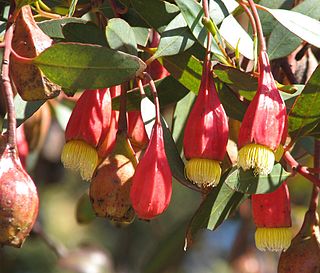
Eucalyptus forrestiana, commonly known as fuchsia gum or fuchsia mallee, is a species of small tree or mallet and is endemic to an area near Esperance, Western Australia. It has smooth grey bark, narrow oblong to lance-shaped adult leaves, flower buds that are square in cross-section, red at maturity and arranged singly in leaf axils, yellow flowers and four-angled, winged fruit.

Eremophila dichroantha, also known as bale-hook eremophila, is a flowering plant in the figwort family, Scrophulariaceae and is endemic to the south-west of Western Australia. It is a shrub with many ascending branches making the plant appear broom-like. It has small, hooked leaves and small, though abundant, violet to lilac-coloured flowers.

Melaleuca cliffortioides is a plant in the myrtle family, Myrtaceae and is endemic to the south-west of Western Australia. It is a small, prickly shrub very similar to Melaleuca podiocarpa but with fewer stamens in the flowers.

Eremophila ionantha is a flowering plant in the figwort family, Scrophulariaceae and is endemic to Western Australia. It is a shrub with many sticky branches, narrow, light green leaves and blue, purple or violet flowers.
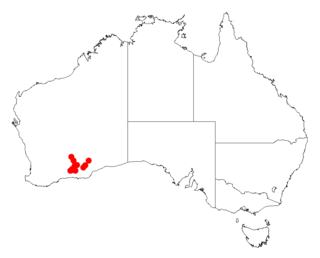
Acacia inamabilis is a shrub belonging to the genus Acacia and the subgenus Phyllodineae that is native to Western Australia.
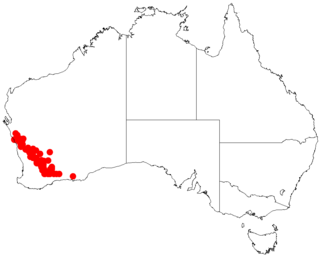
Acacia dielsii, commonly known as Diels' wattle, is a shrub of the genus Acacia and the subgenus Plurinerves that is native to Western Australia.
Hakea pritzelii is a flowering shrub in the family Proteaceae and is endemic to a few small areas in the Great Southern region of Western Australia. It has rigid, pale green leaves and scented red-purple flowers.
Verticordia muelleriana is a flowering plant in the myrtle family, Myrtaceae and is endemic to the south-west of Western Australia. It is an openly branched shrub with relatively large, egg-shaped to circular leaves and long spikes of deep maroon coloured flowers in spring and early summer.
Verticordia stenopetala is a flowering plant in the myrtle family, Myrtaceae and is endemic to the south-west of Western Australia. It is a low shrub with small leaves and heads of pink to magenta-coloured flowers in late spring and early summer.

Kunzea montana, commonly known as mountain kunzea, is a flowering plant in the myrtle family, Myrtaceae and is endemic to the south-west of Western Australia. It is a shrub or small tree with more or less round leaves and heads of cream-coloured to pale yellow flowers on the ends of the branches in late spring. It is an uncommon species, growing on rocky mountain slopes, but all populations are conserved in the Stirling Range National Park.
Conothamnus neglectus is a member of the family Myrtaceae endemic to Western Australia. This open shrub typically grows to a height of 0.2 to 1.0 metre. It blooms in between July and September producing yellow flowers.
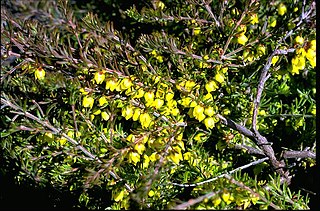
Boronia purdieana is a plant in the citrus family, Rutaceae and is endemic to the south-west of Western Australia. It is a shrub with pinnate leaves and yellow, four-petalled flowers arranged singly in leaf axils.
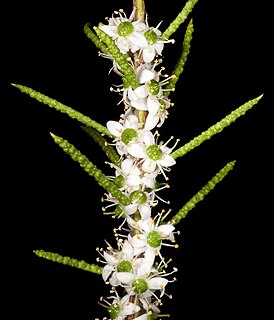
Philotheca deserti is a species of flowering plant in the family Rutaceae and is endemic to inland Western Australia. It is an erect shrub with narrow spindle-shaped, glandular-warty leaves and white flowers arranged singly in leaf axils.

Philotheca tomentella is a species of flowering plant in the family Rutaceae and is endemic to the south-west of Western Australia. It is an undershrub with small club-shaped to cylindrical leaves and white flowers with a pale red central stripe, arranged singly or in groups of up to four on the ends of branchlets.
Goodenia eremophila is a species of flowering plant in the family Goodeniaceae and is endemic to inland areas of Western Australia. It is an ascending herb with linear to elliptic leaves and thyrses of blue flowers.
Pultenaea arida is a species of flowering plant in the family Fabaceae and is endemic to the south of Western Australia. It is a low, spindly, spreading shrub with small, flat, hairy leaves and yellow, red or orange flowers.
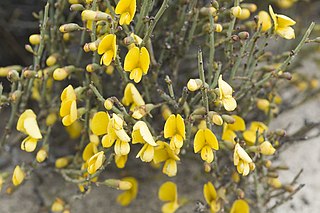
Bossiaea leptacantha is a species of flowering plant in the family Fabaceae and is endemic to southern Western Australia. It is a low, compact, spreading, many-branched shrub, the branches ending in cladodes, the leaves reduced to small scales, and with deep yellow, red and greenish yellow flowers.














